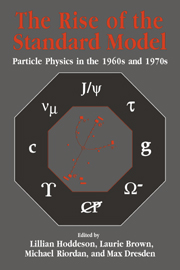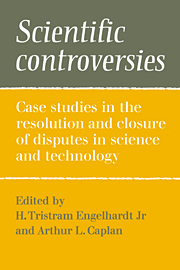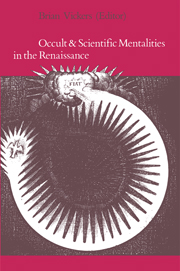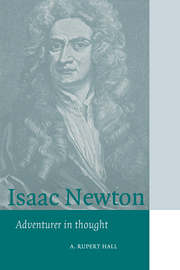Refine search
Actions for selected content:
13588 results in History of science and technology
The role of an editor: some remarks on Whiteside's edition of Newton's mathematical papers*
-
- Journal:
- The British Journal for the History of Science / Volume 43 / Issue 1 / March 2010
- Published online by Cambridge University Press:
- 09 March 2010, pp. 105-112
- Print publication:
- March 2010
-
- Article
- Export citation
Adrian Desmond and James Moore, Darwin's Sacred Cause: Race, Slavery and the Quest for Human Origins. London: Allen Lane, 2009. Pp. xxi+485. ISBN 978-1-846-14035-8. £25.00 (hardback).
-
- Journal:
- The British Journal for the History of Science / Volume 43 / Issue 1 / March 2010
- Published online by Cambridge University Press:
- 09 March 2010, pp. 119-121
- Print publication:
- March 2010
-
- Article
- Export citation
BJH volume 43 issue 1 Cover and Back matter
-
- Journal:
- The British Journal for the History of Science / Volume 43 / Issue 1 / March 2010
- Published online by Cambridge University Press:
- 09 March 2010, pp. b1-b7
- Print publication:
- March 2010
-
- Article
-
- You have access
- Export citation
Robert Bud, Penicillin: Triumph and Tragedy. Oxford: Oxford University Press, 2008. Pp ix+330. ISBN 978-0-19-954161-4. £16.99 (paperback).
-
- Journal:
- The British Journal for the History of Science / Volume 43 / Issue 1 / March 2010
- Published online by Cambridge University Press:
- 09 March 2010, pp. 138-139
- Print publication:
- March 2010
-
- Article
- Export citation
Guy Ortolano, The Two Cultures Controversy: Science, Literature and Cultural Politics in Postwar Britain. Cambridge: Cambridge University Press, 2009. Pp. xi+295. ISBN 978-0-521-89204-9. £55.00 (hardback).
-
- Journal:
- The British Journal for the History of Science / Volume 43 / Issue 1 / March 2010
- Published online by Cambridge University Press:
- 09 March 2010, pp. 143-144
- Print publication:
- March 2010
-
- Article
- Export citation
Mike Jay, The Atmosphere of Heaven: The Unnatural Experiments of Dr Beddoes and His Sons of Genius. New Haven and London: Yale University Press, 2009. Pp. vii+294. ISBN 978-0-300-12439-2. £20.00 (hardback).
-
- Journal:
- The British Journal for the History of Science / Volume 43 / Issue 1 / March 2010
- Published online by Cambridge University Press:
- 09 March 2010, pp. 125-126
- Print publication:
- March 2010
-
- Article
- Export citation
Warwick Anderson, The Collectors of Lost Souls: Turning Kuru Scientists into Whitemen. Baltimore: Johns Hopkins University Press, 2008. Pp. 318. ISBN 978-0-8018-9040-6. £13.00 (hardback).
-
- Journal:
- The British Journal for the History of Science / Volume 43 / Issue 1 / March 2010
- Published online by Cambridge University Press:
- 09 March 2010, pp. 141-142
- Print publication:
- March 2010
-
- Article
- Export citation
Electron diffraction chez Thomson: early responses to quantum physics in Britain
-
- Journal:
- The British Journal for the History of Science / Volume 43 / Issue 2 / June 2010
- Published online by Cambridge University Press:
- 05 February 2010, pp. 245-275
- Print publication:
- June 2010
-
- Article
- Export citation

The Rise of the Standard Model
- A History of Particle Physics from 1964 to 1979
-
- Published online:
- 03 February 2010
- Print publication:
- 13 November 1997

Scientific Controversies
- Case Studies in the Resolution and Closure of Disputes in Science and Technology
-
- Published online:
- 03 February 2010
- Print publication:
- 27 March 1987
A Social History of the “Galois Affair” at the Paris Academy of Sciences (1831)
-
- Journal:
- Science in Context / Volume 23 / Issue 1 / March 2010
- Published online by Cambridge University Press:
- 26 January 2010, pp. 91-119
- Print publication:
- March 2010
-
- Article
- Export citation
Homeomeric Lines in Greek Mathematics
-
- Journal:
- Science in Context / Volume 23 / Issue 1 / March 2010
- Published online by Cambridge University Press:
- 26 January 2010, pp. 1-37
- Print publication:
- March 2010
-
- Article
- Export citation
SIC volume 23 issue 1 Cover and Front matter
-
- Journal:
- Science in Context / Volume 23 / Issue 1 / March 2010
- Published online by Cambridge University Press:
- 26 January 2010, pp. f1-f3
- Print publication:
- March 2010
-
- Article
-
- You have access
- Export citation
Johann Heinrich Lambert's Scientific Tool Kit, Exemplified by His Measurement of Humidity, 1769–1772
-
- Journal:
- Science in Context / Volume 23 / Issue 1 / March 2010
- Published online by Cambridge University Press:
- 26 January 2010, pp. 65-89
- Print publication:
- March 2010
-
- Article
- Export citation
SIC volume 23 issue 1 Cover and Back matter
-
- Journal:
- Science in Context / Volume 23 / Issue 1 / March 2010
- Published online by Cambridge University Press:
- 26 January 2010, pp. b1-b10
- Print publication:
- March 2010
-
- Article
-
- You have access
- Export citation
Definitional Argument in Evolutionary Psychology and Cultural Anthropology
-
- Journal:
- Science in Context / Volume 23 / Issue 1 / March 2010
- Published online by Cambridge University Press:
- 26 January 2010, pp. 121-150
- Print publication:
- March 2010
-
- Article
- Export citation
Early Numerical Analysis in Kepler's New Astronomy
-
- Journal:
- Science in Context / Volume 23 / Issue 1 / March 2010
- Published online by Cambridge University Press:
- 26 January 2010, pp. 39-63
- Print publication:
- March 2010
-
- Article
- Export citation
Alfred Rupert Hall (26 July 1920–5 February 2009) and Marie Boas Hall (18 October 1919–23 February 2009)
-
- Journal:
- The British Journal for the History of Science / Volume 43 / Issue 1 / March 2010
- Published online by Cambridge University Press:
- 25 January 2010, pp. 99-103
- Print publication:
- March 2010
-
- Article
-
- You have access
- HTML
- Export citation

Occult Scientific Mentalities
-
- Published online:
- 12 January 2010
- Print publication:
- 29 June 1984

Isaac Newton
- Adventurer in Thought
-
- Published online:
- 12 January 2010
- Print publication:
- 11 April 1996
